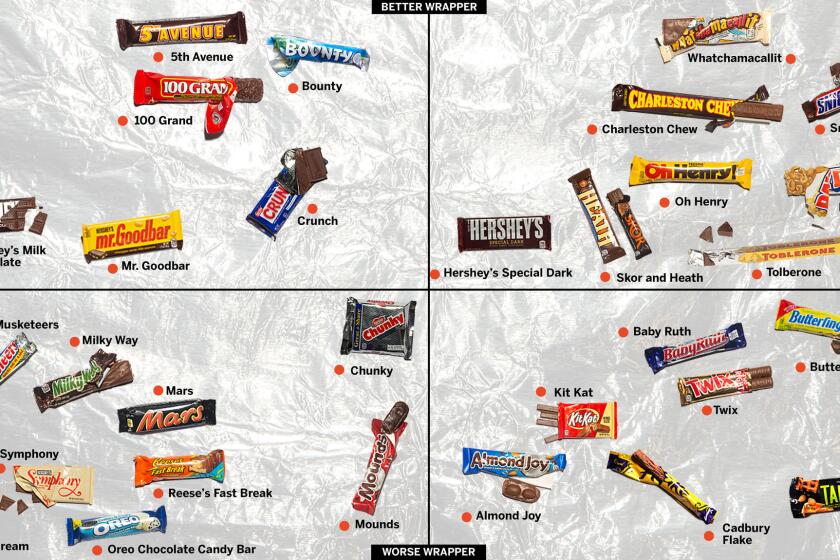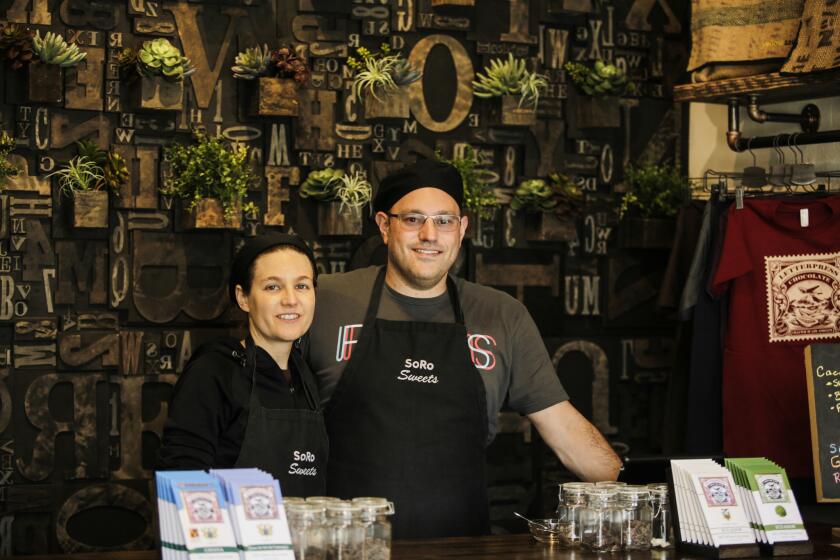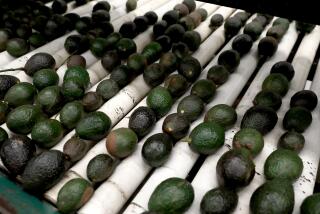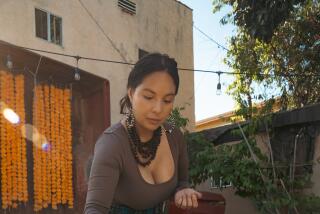The African cocoa farmers who are taking on Big Chocolate

- Share via
In a little clearing in a Ghanaian forest, not far from where grapefruit-size cocoa pods hang heavily from the trees, 67-year-old Yaa Asantewaa breaks into song. Dressed in a threadbare skirt and purple T-shirt, she dances to her uplifting lyrics: “If you want to buy fine cloth — it is cocoa. If you want a meaningful life — it is cocoa.”
Farmers have been singing variations of this song — about how planting cocoa will make you rich — for decades in Ghana, the world’s largest producer after neighboring Ivory Coast. In the first decades of the 20th century, small farmers in West Africa rushed into cocoa farming as if it were the new gold.
Today, between them, Ghana and Ivory Coast produce nearly two-thirds of the global supply of cocoa, the main ingredient in a chocolate industry worth more than $100 billion a year in sales. On Christmas Eve, nearly all the chocolate treats hidden inside stockings by the tree will almost certainly contain cocoa from one of those countries.
But Asantewaa knows only too well that the words to her song are fanciful. Cocoa has not made her rich.
Like most of the 2 million cocoa farmers in West Africa, she is extremely poor. She owns a tiny forest plot from which she harvests just four 140-pound bags of cocoa beans a year. For that, at last year’s prices, she would have earned about $400. The mud houses in her village of Wawase in southern Ghana have no electricity or running water.
The penury of many farmers at the bottom of the chocolate industry’s multibillion-dollar pyramid reflects a much broader issue: Why is it so difficult for poor countries to break out of poverty by extracting higher prices for their raw materials and controlling more valuable areas of the supply chain?
It’s June, which means that we have the longest day of the year to look forward to this month.
Ghana supplies about one-fifth of all cocoa beans, for which it earns about $2 billion a year, less than one-fiftieth of the value of the chocolate that is manufactured, branded and sold. Nana Akufo-Addo, Ghana’s president, says his country is locked in a colonial-style relationship with the world’s chocolate manufacturers in which it provides raw materials only to import finished goods.
“Chocolate is a $100-billion industry and we who produce 65% of the raw material make less than $6 billion from the sweat and toil of our farmers,” he says, referring to the combined sales of Ghana and Ivory Coast. What prevented these two countries, he asks, from earning more by turning beans into cocoa liquor and cocoa butter or even manufacturing finished chocolate bars?
In practice, both Ghana and Ivory Coast, which have high electricity costs and where little chocolate is eaten, have found it hard to wrest a greater share of profits from an industry that keeps most of the added value near the Western consumer markets it serves.
The chocolate industry has been accused of more than keeping its adult farmers in poverty. As long ago as 2001, chocolate makers, including Mars, Nestle and Hershey, signed an agreement to eliminate child labor from their supply chains in Ghana and Ivory Coast where the problem is most acute.
Yet in 2015, the U.S. Labor Department found that the number of children working on cocoa farms — some carrying out dangerous tasks such as spraying pesticide, lugging heavy sacks or wielding machetes — had actually gone up, to 2.1 million. The industry has since signed up to a less ambitious target of reducing child labor by 70% in 2020. Most observers think it will fail.
As if that were not enough, cocoa farming has also been linked to rampant deforestation, particularly in Ivory Coast. Its cocoa production has nearly doubled to 2 million tons over the last decade as farmers clear new forest land.
After years of talk, African governments have decided to act to improve their leverage in the chocolate industry. In July, Ghana and Ivory Coast unilaterally announced a fixed premium of $400 a ton over the benchmark futures price from October 2020. “If you look at OPEC, they are only controlling about 30% to 40% of the global oil supply and they control prices,” says Mahamudu Bawumia, Ghana’s vice president, referring to the oil cartel. “If they have OPEC, we can have COPEC.”
The determination of producer countries to squeeze more value from chocolate might appear to be putting them on a collision course with industry. Business logic suggests that manufacturers, such as Nestle and Ferrero, and trading houses, including Cargill and Olam, are not keen to pay more for ingredients.
Yet, in many ways, the rhetoric coming from Africa chimes with that of the chocolate industry itself.
“We are a food business, so it is absolutely critical that our supply chains are sustainable,” says Victoria Mars, a fourth-generation member of the family and former chairwoman of Mars. “If we don’t have the raw materials, we can’t make our products.”
A combination of self-interest and reputational risk is forcing manufacturers to clean up supply chains that are linked to grinding poverty, child labor and environmental degradation. Some, including Barry Callebaut, a Switzerland-based chocolate maker that is the world’s biggest cocoa buyer, have cautiously welcomed the $400 premium.
Consumers are increasingly interested in the sourcing of their products and under what conditions they are produced. Nongovernmental organizations have ratcheted up the pressure on manufacturers by exposing the darker side of chocolate and most of the big chocolate makers have responded with bold-sounding initiatives.
Mars has committed to spending $1 billion over 10 years on its Cocoa for Generations program, which, it says, will fundamentally overhaul a supply chain it admits is broken. Barry Callebaut has launched a Forever Chocolate initiative, which aims to hit four audited targets by 2025: lift 500,000 farmers out of poverty, reduce child labor to zero, become carbon- and forest-positive, and have fully sustainable ingredients.
Companies say these efforts represent a step-change in their thinking. “It’s getting away from old-fashioned corporate social responsibility and creating real impact,” says Nicko Debenham, Barry Callebaut’s head of sustainability. He criticizes what he regards as the piecemeal certification programs such as Fairtrade and Rainforest Alliance. “We can’t just hit replay on what we’ve done and what other people have done. To create impact, we’ve got to do this at scale.”
As well as protecting their reputations, chocolate makers worry that their supply of cocoa could dry up if farmers are destitute. “If our farmers are not able to thrive, if they are not able to make a decent living, if they are not able to educate their children, then they are not going to stay farmers,” Mars says. “We all have to work this out together.”
With industry and producer countries now purportedly on the same side, surely something can be done to improve cocoa-farming conditions that some compare to modern slavery?
Debenham has been banging his head against the problem for years. Since 2016, he has been overseeing Barry Callebaut’s Forever Chocolate initiative. He describes it as the industry’s best effort yet to tackle structural problems that, he says, can be solved only by cooperation between governments in producer and consumer countries as well as nongovernmental organizations and the industry.
“Everybody has to play their role, not just by telling industry we’re going to ban you, we’re going to punish you, we’re going to beat you,” he says.
Barry Callebaut, he says, is rolling out a combination of initiatives that can be carried out at scale. In Ghana, it has bought a licensed buying company, Nyonkopa, to get around a ban on foreign firms purchasing cocoa directly from farmers, allowing it to distribute seedlings, shade trees and yield-enhancing advice to small holders.
After decades in which inherited plots have been split among offspring, farm sizes are simply too small, Debenham says. “It’s not an acceptable living. It’s below the poverty line,” he says, adding that, in the long run, the answer is bigger farms and fewer farmers.
If the overarching goal is alleviating poverty, defined by the World Bank as living on less than $1.90 a day adjusted for prices, Debenham has concluded that the key is diversification away from chocolate. Raising yields, say experts, is not the whole solution because if too many farmers are successful, aggregate output will rise and prices inevitably fall. In 2017, cocoa prices tumbled nearly 40%, a disaster for farmers blamed partly on surging production in Ivory Coast.
We’ve become accustomed to restaurants with open kitchens, coffee shops with on-site roasters, taquerias where you can see the tortillas being made — but how about a shop where you can watch your chocolate go from bean to bar?
Instead, Barry Callebaut has collected data from 230,000 cocoa farmers and is offering tailor-made business plans to help them increase income by growing vegetables, making soap, selling honey or keeping livestock. One option is to raise hens whose eggs provide both protein and cash. Eggs sell for half a cedi each, or about $2.65 for a crate of 30.
John Afful, a 43-year-old cocoa farmer in Ghana’s southern Ashanti region, says, “Before I had poultry, things were tough. It was even hard to send my kids to school.” Asked what ambitions he has for his five children, Afful replies definitively: “I don’t want them to be cocoa farmers.”
Barry Callebaut has also signed up to so-called Scope 3 carbon targets, which means not only being carbon neutral in its energy and supply-chain footprint, but also accounting for historical land use changes. By 2025, it has pledged that none of its cocoa will come from farms that were converted from forest after 2005, a claim backed up through laborious farm-boundary surveys and satellite imagery. It has organized child protection committees to report violations on about one-quarter of its cocoa farms.
According to PwC, which audits the program, these actions are having some effect. Barry Callebaut has nudged 185,000 farmers above the $1.90 poverty threshold since 2016 and achieved a 6.7% reduction in emissions in the year to the end of August. There were 3,867 cases of reported child labor in the period, though 2,200 are being dealt with.
Many are skeptical about how effective industry programs can be in tackling what campaigners consider a structural imbalance in power between huge multinationals and the poor farmers who supply them.
Paul Schoenmakers, head of impact at Tony’s Chocolonely, a niche Dutch chocolate manufacturer that aims to act as a catalyst for change in the industry, says: “It is like killing a forest fire with a glass of water.”
Michiel Hendriksz, a former cocoa executive at commodities trader Archer Daniels Midland, says the attempt by Ghana and Ivory Coast to impose the $400 premium will fail. The premium, known as the “living income differential,” or LID, is intended to increase farm-gate prices to levels high enough that farmers can send their children to school, eat healthfully and pay medical bills.
But campaigners doubt the ability of African governments to influence prices that are determined by traders buying and selling derivative contracts worth some 40 times physical supplies. Unlike oil wells, cocoa trees cannot simply be turned off to reduce supply. Even if prices go up, say traders, that will encourage farmers to grow more, sending prices back down again.
“LID is a bad poker game by people who cannot play poker,” says Hendriksz, who argues that the whole cash-crop model is a recipe for continued poverty. He has more radical advice for producers: “If they abandon cocoa, prices would go through the roof. Grow more food, produce less cocoa and push up the price.”
As well as seeking to raise cocoa prices, Ghana wants to incentivize chocolate manufacturers to grind cocoa beans domestically. But highly mechanized factories employ few people and, thanks to generous tax breaks, contribute little to the treasury.
Some entrepreneurs have tried to make chocolate in Ghana. But most have hit problems. Ghana has no sizable dairy industry, forcing them to import milk. Electricity prices are high. So are temperatures, obliging them to spend heavily on refrigeration.
“It’s hard to manufacture at origin,” says Victoria Crandall, a Lagos-based former commodities analyst for five years in Ivory Coast. “Your production costs are always going to be more than in Europe or the U.S.” Manufacturers, she says, stay close to their consumers, which means the Westerners who can afford chocolate.
Like many, Crandall sees no easy solutions.
“There has to be a radical transformation of the whole industry,” she says. “If consumers want an ethical chocolate bar and they want farmers to be flourishing, they have to cut out the trading houses and they have to cut out Big Chocolate.”
© The Financial Times Ltd. 2019. All rights reserved. FT and Financial Times are trademarks of the Financial Times Ltd. Not to be redistributed, copied or modified in any way.
More to Read
Inside the business of entertainment
The Wide Shot brings you news, analysis and insights on everything from streaming wars to production — and what it all means for the future.
You may occasionally receive promotional content from the Los Angeles Times.












